Decor
What Does a Chinese Fan Symbolize?

Upon seeing a Chinese fan, our minds instantly associate it with beauty, refinement, and heritage. Within Chinese tradition, the fan carries profound symbolic significance, mirroring diverse elements of life and societal values.
From being a status symbol to a protective talisman, the Chinese fan has a rich history and significance. Its intricate designs and delicate movements convey layers of meaning that have evolved over centuries.
Understanding the symbolism behind the Chinese fan offers insight into the values and beliefs of the culture. In this brief exploration, we will delve into the multifaceted meanings and representations of the Chinese fan, shedding light on its enduring significance in Chinese art, literature, and daily life.
Key Takeaways
- Chinese fans have evolved from practical tools to symbolic objects, reflecting the dynamic interplay between art, culture, and tradition.
- They hold significant cultural and symbolic meanings, representing Confucian, Taoist, and Buddhist beliefs, as well as conveying respect, gratitude, and social status.
- Chinese fans serve as powerful tools for nonverbal communication and storytelling, reflecting evolving ideals of beauty, intellect, and social hierarchy.
- The contemporary use of Chinese fans showcases a harmonious blend of heritage and progressive values, with adaptations that incorporate sustainable materials, digital printing techniques, and fashion-forward designs.
Origins of Chinese Fans
The origins of Chinese fans can be traced back to ancient times, evolving from practical tools to symbolic objects with deep cultural significance. Fan craftsmanship in ancient China was a revered art form, with skilled artisans meticulously crafting fans from a variety of materials such as bamboo, silk, feathers, and even precious metals. These materials were chosen not only for their durability but also for their symbolic meanings. For instance, bamboo symbolized resilience and integrity, while silk represented elegance and luxury.
Fan craftsmanship reached its pinnacle during the Song Dynasty, where delicate paper fans adorned with intricate paintings became highly sought after. The process of creating these fans required meticulous attention to detail and a deep understanding of symbolism, as every aspect of the fan, from its shape to the motifs depicted, held cultural and spiritual significance.
The evolution of Chinese fan materials and craftsmanship reflects the profound cultural and symbolic importance of fans in Chinese society. Understanding the historical significance of fan craftsmanship and materials provides insight into the deep-rooted symbolism attached to Chinese fans, making them much more than mere accessories.
Evolution of Fan Designs

As we explore the evolution of fan designs, we uncover a rich tapestry of historical styles that have been influenced by the diverse cultures of China.
From the traditional folding fans of ancient times to the intricate and symbolic motifs depicted on fans, the evolution of fan designs provides insight into the dynamic interplay between art, culture, and tradition.
Furthermore, the adaptation of fan designs in modern times reflects the enduring relevance and influence of this cherished symbol in Chinese culture.
Historical Fan Styles
Through the centuries, the evolution of Chinese fan designs has woven a rich tapestry of historical, symbolic, and comparative significance.
Historical fan styles in China have evolved from simple handheld objects to elaborate works of art, reflecting the cultural and societal changes over time. The earliest fans were made of feathers or silk, and were primarily used for fanning and cooling.
As time progressed, fan styles became more diverse, incorporating intricate paintings, calligraphy, and embroidery, each representing different dynasties and artistic movements. The folding fan, for example, became a popular style during the Song dynasty and remains iconic in Chinese fan culture.
The evolution of fan designs not only holds evolutionary and cultural significance but also serves as a window into the artistic and societal developments throughout Chinese history.
Influence of Culture
Evolution of fan designs in China mirrors the dynamic shifts in cultural and societal influences, revealing a profound tapestry of historical and symbolic significance. Cultural influence has intricately woven its threads into the delicate fabric of fan designs, manifesting in various symbolic gestures and fan etiquette. The evolution of fan designs reflects the fusion of Confucian, Taoist, and Buddhist beliefs, resulting in diverse fan styles that represent different cultural and societal influences.
| Fan Etiquette | Feng Shui |
|---|---|
| Used to convey respect and gratitude | Fans used to enhance the flow of positive energy |
| Different fan gestures symbolize various meanings | Fans strategically placed to optimize harmony and balance |
The influence of culture on fan designs is a testament to the profound impact of societal values and beliefs on art and everyday practices.
Modern Fan Adaptations
The modern adaptations of fan designs reveal a convergence of traditional symbolism with contemporary aesthetics, reflecting the ongoing evolution of cultural influences and societal values.
In the realm of modern fan fashion, the fan accessories industry has witnessed a fascinating amalgamation of historical significance and innovative design.
- The intricate hand-painted motifs on traditional Chinese fans have been reimagined using digital printing techniques, resulting in vivid and detailed designs that captivate the eye.
- This juxtaposition of ancient artistry with modern technology captures the essence of cultural preservation in a rapidly changing world.
- Furthermore, modern fan designs often incorporate sustainable materials and eco-friendly production methods, symbolizing a harmonious blend of heritage and progressive values.
These modern adaptations not only pay homage to the rich tradition of fan symbolism but also pave the way for a new era of cultural appreciation and expression through fashion.
Fan Symbolism in Art and Literature
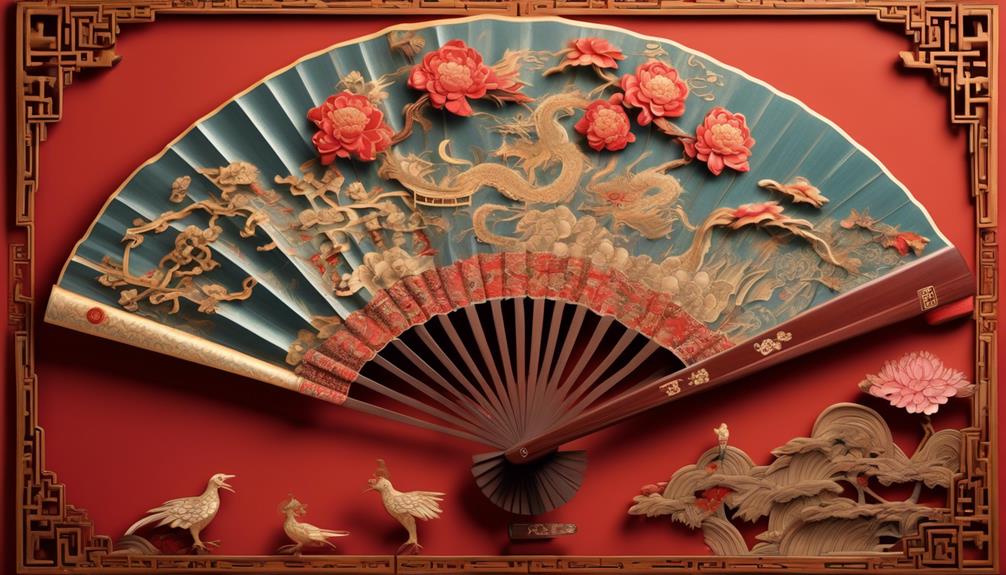
Let's explore the significance of the fan in Chinese art and literature, where it has been a powerful symbol for centuries.
From delicate paintings to evocative poetry, the fan has been used to convey emotions, tell stories, and express cultural ideals.
Fan in Paintings
In Chinese paintings, the fan is often depicted as a symbol of elegance, refinement, and status, reflecting the cultural significance of fans in art and literature.
The delicate folds of the fan in the hands of a noble lady create an image of grace and sophistication, evoking a sense of timeless beauty.
The fan's presence in a scholar's hand signifies erudition and wisdom, as it becomes an extension of the scholar's intellect and discernment, adding layers of complexity to the artwork.
The evolution of fan symbolism in artistic expressions mirrors the transformation of societal values and aesthetics throughout Chinese history.
The fan's portrayal in paintings serves as a cultural mirror, reflecting the evolving ideals of beauty, intellect, and social hierarchy.
Through this artistic lens, the fan becomes a powerful emblem, conveying the nuanced intricacies of Chinese culture and its artistic traditions.
Fan in Poetry
From paintings to poetry, the fan's symbolism in Chinese art and literature transcends time, reflecting the evolution of societal values and aesthetic ideals throughout history.
In poetry, the fan is often used as a metaphor to convey emotions, desires, and societal roles. Fan motifs in fashion are frequently intertwined with poetic expressions, symbolizing elegance, grace, and femininity.
Poets have employed the fan as a symbol to depict the fleeting nature of beauty, much like the delicate fluttering of a fan. Additionally, the intricate movements of a fan in traditional Chinese dance symbolize storytelling and emotions, enhancing the poetic narratives within the performances.
The fan's significance in poetry mirrors its role in paintings, both serving as a medium for conveying emotions, societal norms, and aesthetic beauty in the rich tapestry of Chinese art and literature.
Fans as Status Symbols
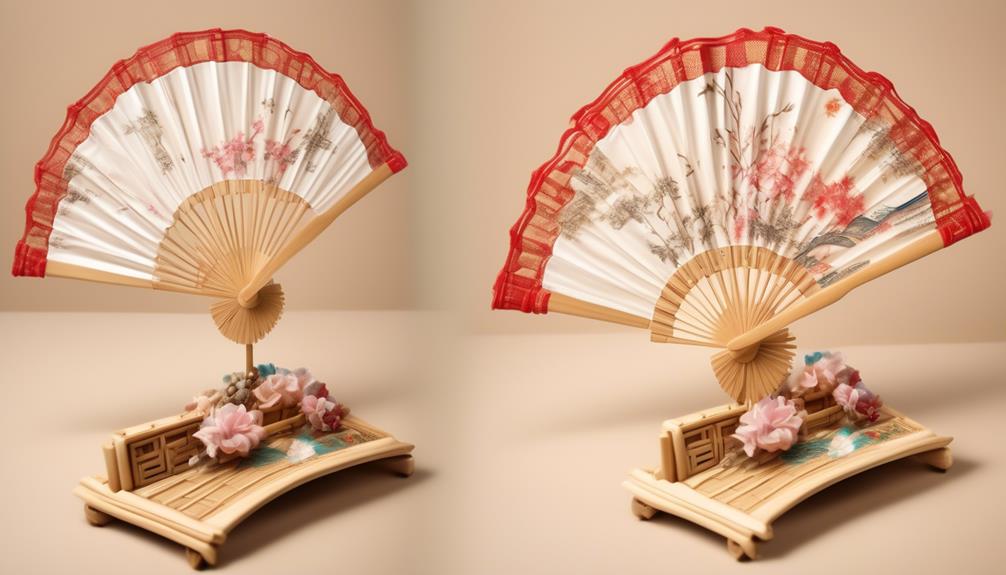
Fans in Chinese culture functioned as more than just a cooling tool; they were a symbol of status and refinement, reflecting the social standing and taste of the owner. In the context of social hierarchy, fashion, and historical significance, fans weren't only practical accessories but also indicators of one's position in society.
When a person of high status displayed an intricately designed fan, it signified their wealth and sophistication, setting them apart from the lower classes. On the other hand, fans were also a means of cultural exchange, as they were often exchanged as gifts among the elite, fostering diplomatic relations and alliances. The way a fan was held and manipulated also conveyed subtle messages to those who understood the nuances, adding layers of complexity to social interactions.
Additionally, fans weren't only a Chinese symbol of status but were also found in other cultures, such as the Japanese and European, each with its own unique designs and meanings, showcasing the diversity of fan symbolism across different societies.
Fan Etiquette and Gestures

During courtly gatherings, the subtle gestures of opening and closing a fan conveyed unspoken messages of agreement or disagreement, adding a layer of complexity to social interactions. Fan etiquette and gestures have deep roots in Chinese culture, with a rich history of symbolic communication. The way a fan was held, waved, or presented could convey a range of meanings, making it an essential tool for expressing emotions and opinions without words.
| Gesture | Meaning |
|---|---|
| Opening and closing fan | Agreement or disagreement |
| Fanning slowly | Showing interest or approval |
| Covering the mouth with the fan | Indicating laughter or coyness |
| Placing the fan on the heart | Expressing deep affection or gratitude |
| Tapping the fan lightly | Signaling impatience or annoyance |
Understanding these cultural gestures was crucial for navigating social interactions in historical Chinese society. Mastery of fan etiquette allowed individuals to partake in sophisticated and meaningful communication, adding depth and nuance to their interactions. Even today, the graceful art of using a fan to convey unspoken messages continues to be appreciated as a cultural treasure.
Fan Symbolism in Traditional Festivals
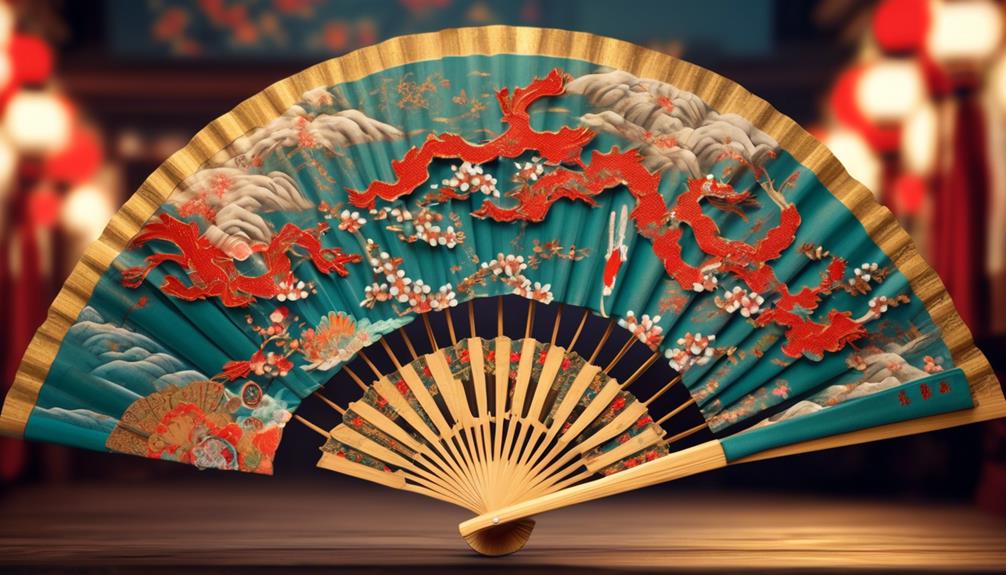
In traditional festivals, the symbolism of fans intertwines with cultural rituals, weaving layers of meaning and tradition into the vibrant tapestry of celebration.
The fan craftsmanship, with its traditional techniques, becomes a visual spectacle, reflecting the dedication and artistry of the makers. The intricate designs and delicate materials used in crafting the fans elevate them to the status of revered cultural artifacts.
In the lively atmosphere of festivals, these fans play a crucial role in storytelling, often becoming the visual aids in the retelling of folklore traditions. As the fans gracefully move through the air, they transport the audience to ancient times, where myths and legends come to life.
The fans, in their graceful movements, mirror the fluidity of tradition and the continuity of cultural narratives, connecting the present with the past. They serve as a link between generations, embodying the spirit of time-honored customs and carrying forward the rich heritage of the Chinese people.
Feng Shui and Fans
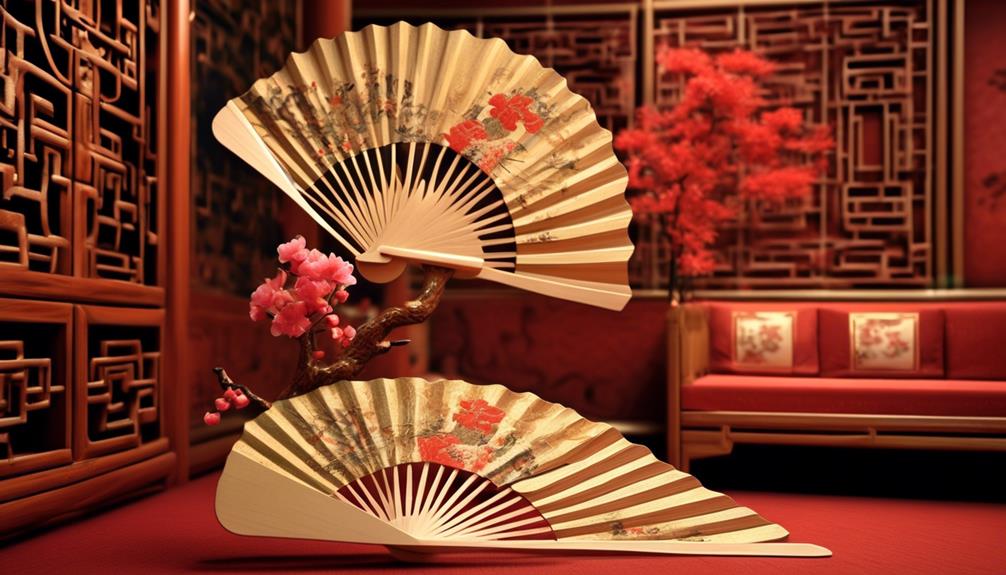
Amidst the ancient practice of Feng Shui, the fan emerges as a symbol of both elegance and purpose, intricately woven into the fabric of Chinese cultural beliefs and traditions. In the realm of feng shui, fans are revered for their ability to circulate and redirect energy, known as "qi," to create harmonious environments. When strategically placed, fans can enhance the flow of positive energy within a space, contributing to a balanced and vibrant atmosphere.
| Feng Shui Tips for Fans | Benefits |
|---|---|
| Place fans in the southeast corner of a room | Enhances wealth and prosperity |
| Avoid placing fans directly facing doors | Prevents energy from flowing out |
| Use fans with auspicious symbols or designs | Attracts good fortune and positivity |
| Keep fans well-maintained and dust-free | Promotes clarity and freshness in the air |
In interior decor, fans are not only functional but also carry deep cultural symbolism. They are often incorporated into design elements to evoke a sense of tradition and grace. Furthermore, fans have transcended traditional boundaries and have become fashionable accessories, reflecting enduring cultural influence on modern fashion trends. Whether adorning living spaces or gracing the runway, the fan remains an enduring symbol of harmony and sophistication.
Fans as Tools for Communication

Throughout history, fans have served as powerful tools for non-verbal communication, conveying subtle messages through their intricate movements and designs.
In different cultures, fans have held various symbolic meanings, from expressions of status and elegance to carrying secret messages and emotions.
Understanding the cultural significance of fans provides a unique insight into the art of non-verbal communication and the rich tapestry of human expression.
Symbolic Gestures in Fans
Across various cultures, fans have served as powerful tools for nonverbal communication, conveying intricate meanings through symbolic gestures. In many societies, the way a fan is held, opened, or closed can carry significant cultural significance. For example:
- In Japanese culture, the act of partially opening a fan symbolizes a desire to converse, while a fully open fan indicates a wish for privacy.
- At traditional festivals, fan etiquette plays a crucial role in conveying respect and courtesy.
Conversely, in Victorian England, fanning oneself at a slow pace was seen as flirtatious, while fanning rapidly indicated distress or an urgent message. The subtle movements of the fan were carefully observed and interpreted in social settings.
These examples illustrate the rich history and diverse interpretations of symbolic gestures through fans, highlighting their importance in nonverbal communication across different cultures.
Cultural Significance of Fans
The historical and symbolic significance of fans as tools for nonverbal communication becomes further pronounced when examining their cultural implications in various societies. Across different cultural traditions, fans have been used as symbolic gestures to convey a wide range of messages.
In China, the intricate movements of a fan were considered an art form, with specific gestures and positions holding distinct meanings. Similarly, in Japan, the use of fans in traditional dance and theater communicated emotions and narrative elements.
Even in Western societies, fans were utilized as a means of nonverbal communication, with subtle movements conveying messages in social settings. The cultural significance of fans as tools for communication highlights the universal human need for nonverbal expression and the diverse ways in which different societies have incorporated fans into their symbolic lexicon.
Symbolic Meanings of Fan Colors

Different colors of fans have held symbolic meanings in Chinese culture for centuries, reflecting various aspects of life, beliefs, and traditions. The evolution of designs and the cultural significance of fan colors have been deeply intertwined with traditional festivals and everyday life. Here are the symbolic meanings of fan colors:
- Red:
- Represents joy, luck, and happiness.
- Often used in weddings and festivals to bring good fortune and celebration.
- Black:
- Symbolizes dignity, constancy, and solemnity.
- Commonly used in funerals and to express respect and seriousness.
The colors of fans in Chinese culture have evolved to carry a rich tapestry of meanings, reflecting the depth of Chinese traditions and beliefs. Understanding the symbolic meanings of fan colors provides insight into the historical and cultural significance attached to them. Whether vibrant red for joyous celebrations or solemn black for moments of respect, these colors on fans serve as visual representations of the values and beliefs deeply rooted in Chinese culture.
Fans as Tokens of Good Luck
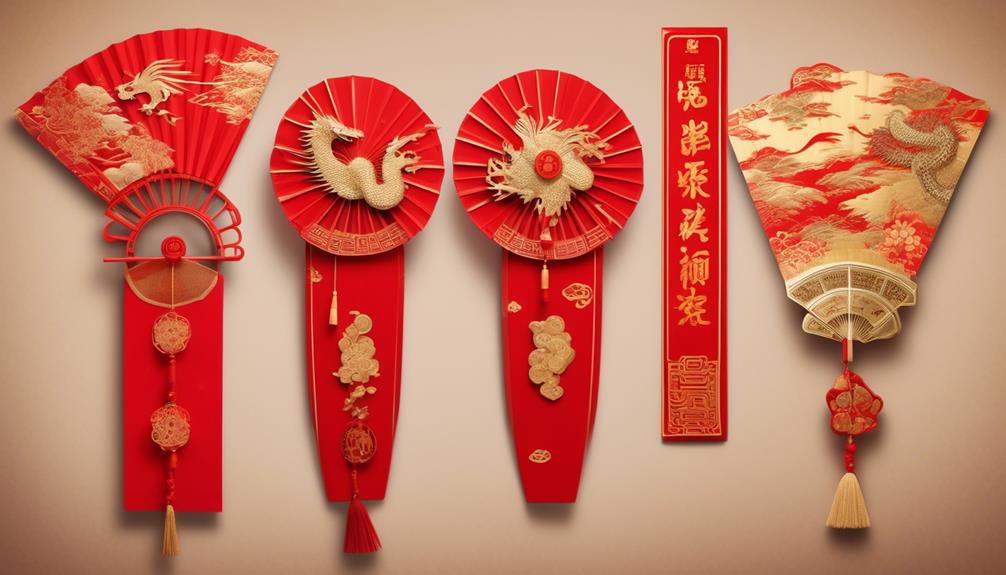
Having explored the symbolic meanings of fan colors in Chinese culture, we now turn to the intricate significance of fans as tokens of good luck.
In Chinese tradition, fans have long been revered as symbols of good fortune and prosperity. Fan rituals are deeply ingrained in Chinese customs, with the act of gifting or receiving a fan believed to bestow blessings upon the recipient. The delicate artistry and elegant designs of fans are thought to attract positive energy and ward off negative influences, making them essential accessories in auspicious ceremonies and celebrations.
Superstitions about fans abound in Chinese culture, with various beliefs dictating the proper handling and display of these cherished items. It's widely held that fanning someone while they're sleeping is inauspicious, as it's believed to symbolize the hastening of that person's death. Conversely, fanning a couple or family while they dine is considered a gesture of goodwill, symbolizing the bestowal of happiness and prosperity upon them.
These superstitions reflect the deep-rooted belief in the power of fans to influence the course of one's destiny, making them revered tokens of good luck in Chinese tradition.
Fans as Protective Talismans
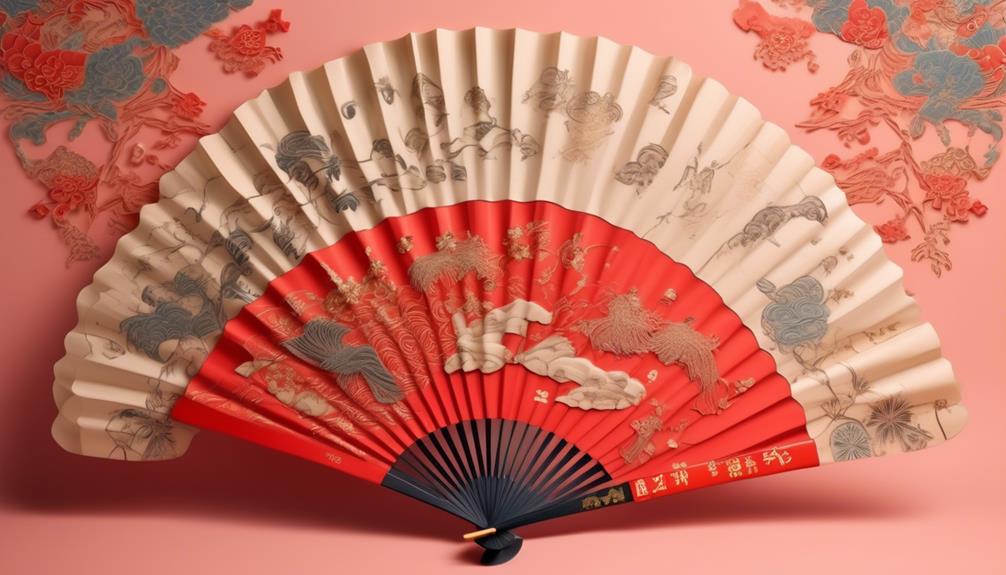
Throughout history, fans have served as protective talismans, offering a shield against malevolent forces and imbuing their bearers with a sense of security and spiritual fortitude. In many cultures, fans aren't merely decorative accessories but are believed to possess protective charms that safeguard the bearer from harm. This spiritual significance is deeply rooted in the symbolism of fans as instruments of protection.
Imagine a delicate silk fan, intricately painted with auspicious symbols, held by a noblewoman as she gracefully wards off negative energy during a traditional Chinese ceremony. The fan not only serves as a shield against malevolent forces but also exudes an aura of spiritual strength and resilience.
In contrast, in ancient Japan, the samurai would carry iron fans called 'tessen' as both a defensive weapon and a symbol of their status. The tessen wasn't only a tool for protection in battle but also a representation of the warrior's unwavering resolve and indomitable spirit.
Fans as protective talismans have transcended cultural boundaries, embodying the universal human desire for security and spiritual fortitude in the face of adversity.
Fans in Chinese Wedding Traditions
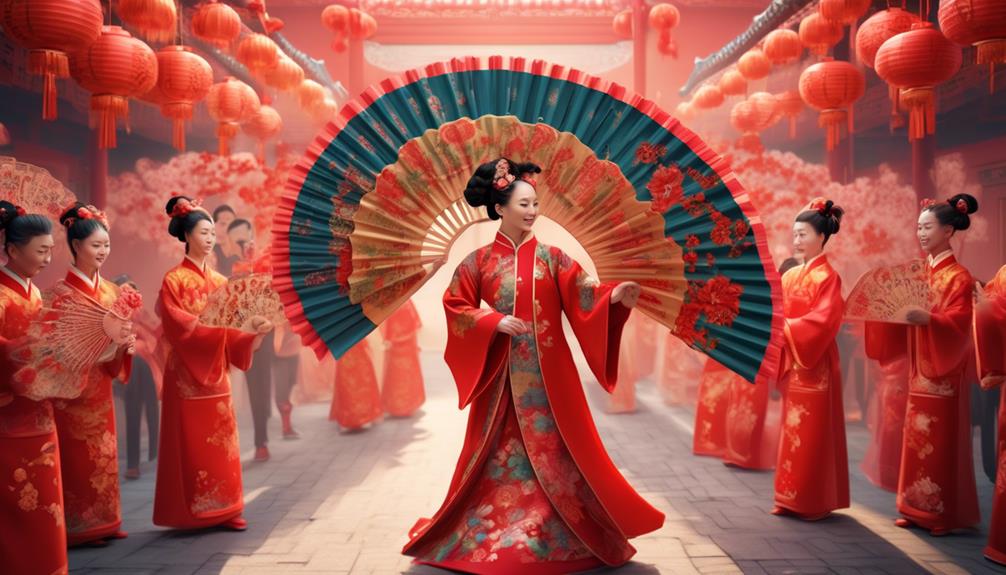
In Chinese wedding traditions, fans have long held a symbolic significance, serving as more than just decorative accessories. Chinese fan craftsmanship plays a significant role in these traditions, with fans often being intricately designed and serving as cultural symbols.
Fans aren't only used by the bride to hide her face, symbolizing modesty and her reluctance to leave her family, but they also hold cultural significance. For example, in some regions of China, the fan is considered a symbol of the bride's transition from girlhood to womanhood, signifying her readiness for marriage.
Additionally, the delicate artistry and craftsmanship of the fan mirror the beauty and intricacy of the marital union. Moreover, the fan's ability to create a gentle breeze represents the hope for a smooth and harmonious marriage.
Comparatively, the use of fans in Chinese wedding traditions contrasts with their role as protective talismans, highlighting the diverse symbolism and cultural depth associated with these traditional Chinese accessories.
Contemporary Significance of Chinese Fans
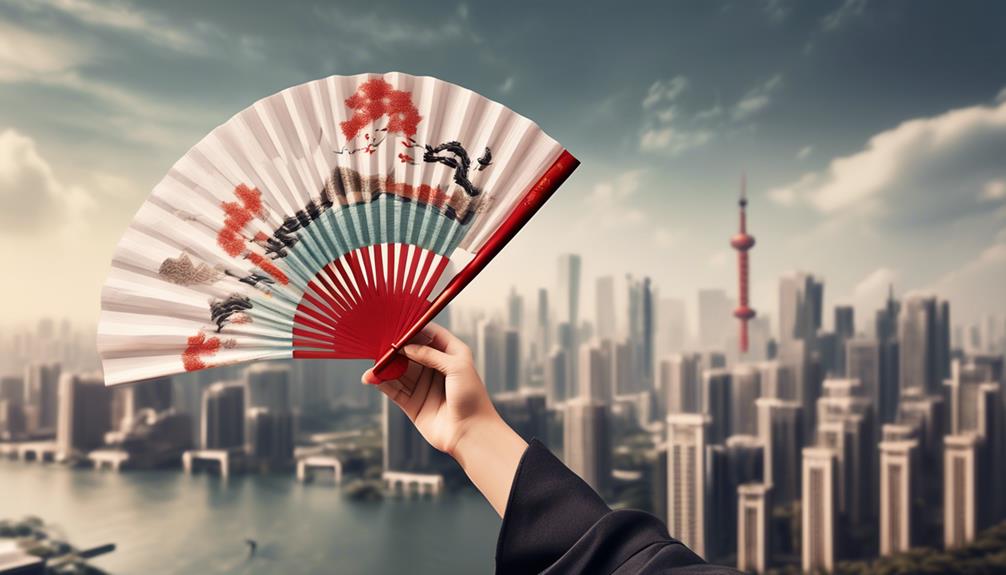
Fans have evolved to encompass contemporary significance in Chinese culture, embodying a blend of tradition and modern expression. In today's China, fans aren't only cherished for their historical and cultural significance but have also found contemporary adaptations that reflect the dynamism of Chinese society.
The cultural symbolism of Chinese fans continues to be prominent, with their versatility and elegance making them a popular choice for various occasions. Fashion Statements: In contemporary Chinese society, fans have become a fashionable accessory, with intricate designs and vibrant colors that complement modern attire. They're often used as a stylish addition to traditional costumes or incorporated into everyday fashion, symbolizing a harmonious blend of the old and the new.
Artistic Performances: Chinese fans are widely utilized in artistic performances, such as dance and theater, where they serve as extensions of the performers' expressions. The graceful movements of the fan add an enchanting visual element to the art forms, captivating audiences with their cultural significance and aesthetic appeal.
The contemporary adaptations of Chinese fans highlight their enduring relevance and cultural resonance, emphasizing their ability to transcend time and symbolize the rich heritage of China.
Frequently Asked Questions
What Are Some Common Superstitions or Taboos Associated With Chinese Fans?
We've learned that Chinese fans hold deep cultural significance and are linked to various superstitions and taboos.
In traditional Chinese medicine and healing practices, fans are believed to influence the flow of qi, representing energy and balance. As such, there are superstitions around using fans inappropriately, as it may disrupt this balance.
Taboos include never using a fan to point at people or to extinguish a flame, as these actions are seen as disrespectful and inauspicious.
How Do Chinese Fans Play a Role in Traditional Chinese Medicine or Healing Practices?
Chinese fans play a significant role in traditional Chinese medicine and healing practices. They're used in therapeutic fan dancing, a form of exercise believed to promote physical, mental, and spiritual well-being.
The rhythmic movements of the fan dance are thought to stimulate energy flow and balance within the body, aligning with the principles of traditional Chinese medicine.
The fans' symbolic and practical significance is deeply woven into the fabric of Chinese healing traditions.
Are There Any Specific Rituals or Ceremonies Involving Chinese Fans in Chinese Culture?
We have observed that fan dances and ceremonial use of fans are prevalent in Chinese culture. The significance of fan making craftsmanship and its cultural importance is deeply rooted in Chinese traditions.
The ceremonial use of fans in Chinese rituals and ceremonies reflects the rich symbolism and historical significance associated with this cultural artifact. These practices provide a window into the intricate and symbolic nature of Chinese cultural traditions.
What Are Some Lesser-Known Historical Figures or Stories Related to Chinese Fans?
Legendary figures from Chinese history, like Empress Wu, have been associated with Chinese fans, showcasing their cultural significance.
These fans weren't just tools for cooling, but also symbols of status and power.
The intricate designs and materials used in these fans were often linked to the Silk Road trade, reflecting the blending of different cultures.
Understanding the lesser-known stories related to Chinese fans offers a deeper insight into their historical and symbolic importance.
How Have Chinese Fans Influenced Other Cultures Outside of China?
Cultural exchange with Chinese fans has influenced fashion trends worldwide. Like a gentle breeze, these delicate accessories swept across cultures, shaping styles and traditions.
From ancient court dances to modern runway shows, the fan's symbolic elegance captivates hearts and minds. Its influence transcends borders, leaving an indelible mark on the world's fashion landscape.
As we delve into its historical significance, we uncover a tapestry of cultural exchange and sartorial evolution.
Does the Chinese Fan Symbolize Good Luck or Prosperity in Chinese Culture?
The Chinese fan has long been a symbol of good luck and prosperity in Chinese culture. It is commonly seen as a decorative item during traditional Chinese New Year celebrations, often with intricate designs and vibrant colors. Just like a traditional Chinese New Year dish, the Chinese fan brings joy and abundance to those who possess it.
Conclusion
In conclusion, Chinese fans have a rich history and deep symbolism in Chinese culture. Interestingly, over 60% of Chinese households own at least one traditional hand fan, showing the enduring significance of this cultural symbol.
From their origins in ancient China to their use in contemporary society, Chinese fans continue to be cherished for their beauty, artistry, and symbolic meaning. They serve as a unique and timeless representation of Chinese traditions and beliefs.
- About the Author
- Latest Posts
Introducing Ron, the home decor aficionado at ByRetreat, whose passion for creating beautiful and inviting spaces is at the heart of his work. With his deep knowledge of home decor and his innate sense of style, Ron brings a wealth of expertise and a keen eye for detail to the ByRetreat team.
Ron’s love for home decor goes beyond aesthetics; he understands that our surroundings play a significant role in our overall well-being and productivity. With this in mind, Ron is dedicated to transforming remote workspaces into havens of comfort, functionality, and beauty.
Southeast Asia Decor
Batik: Cultural Symbolism in Modern Interior Design
Key to enhancing modern interiors, batik’s vibrant patterns tell stories of culture and craftsmanship; discover how to transform your space with meaningful design.
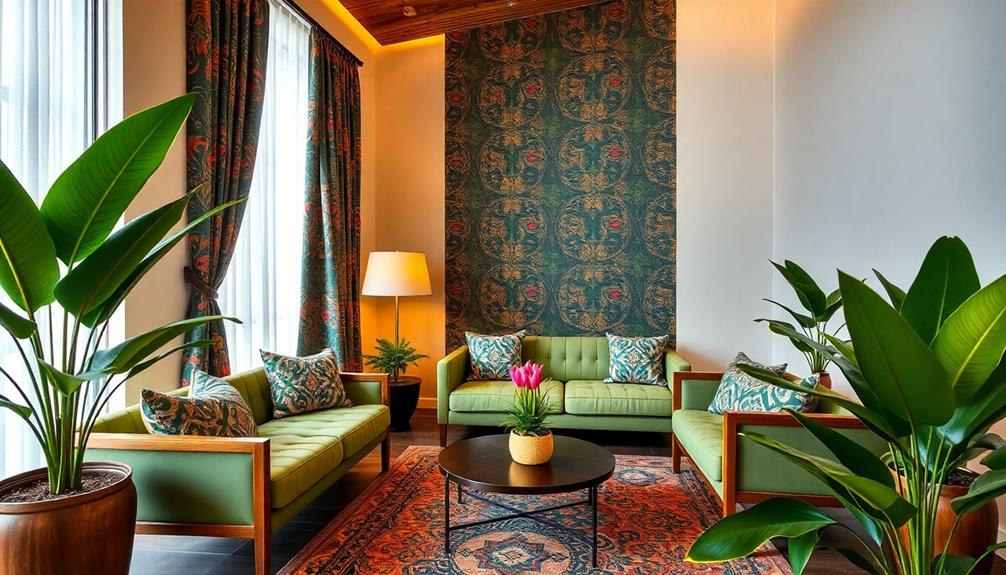
Batik isn't just a beautiful textile; it's a vibrant cultural symbol that enriches modern interior design. You can incorporate its intricate motifs and bright colors into your home, enhancing both aesthetics and storytelling. Each pattern holds meaning, like the Kawung symbolizing balance or Parang representing strength. These designs can be used in cushions, curtains, and art pieces, bringing depth and emotion to your space. By integrating batik, you're not just decorating; you're connecting your environment to a rich heritage. If you explore further, you'll uncover how batik transforms interiors into narratives of culture and craftsmanship.
Key Takeaways
- Batik's intricate motifs reflect cultural values, enhancing narratives, and transforming interior spaces into rich tapestries of stories.
- Contemporary batik blends traditional designs with modern aesthetics, making it suitable for various decor elements like cushions and curtains.
- Regional variations in batik patterns showcase Indonesia's diverse cultural heritage, enriching interior design with unique symbolic meanings.
- Incorporating sustainable materials and eco-friendly practices in batik production supports local artisans and preserves cultural heritage.
- Batik's global influence and recognition as a cultural symbol elevate its significance in modern interior design, connecting spaces to deeper narratives.
Historical Significance of Batik
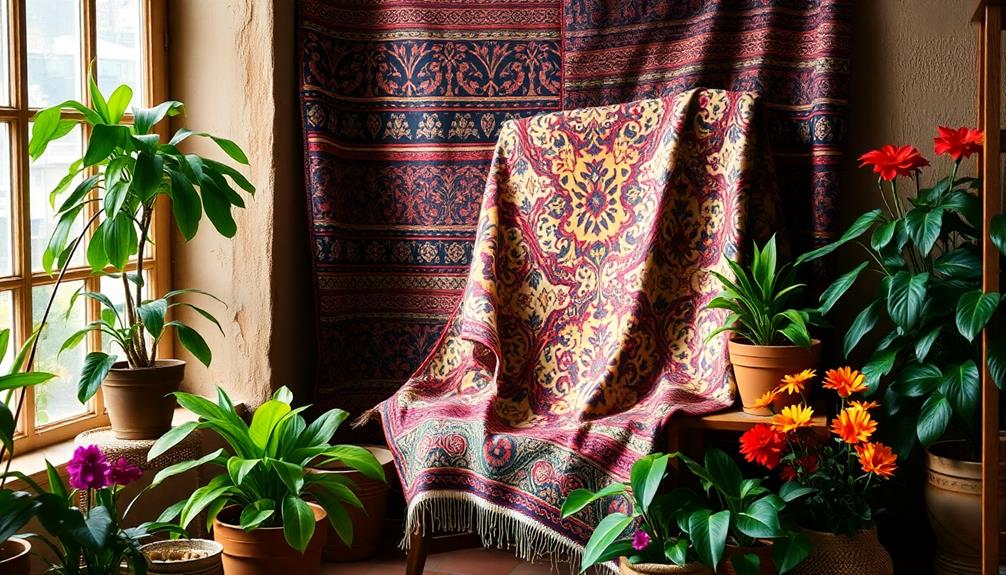
Although batik may seem like just a beautiful textile to you, its historical significance runs deep, rooted in over 2000 years of tradition originating in Indonesia. The term "batik" comes from the Javanese word "ambatik," meaning cloth with little dots, which reflects the intricate dyeing techniques that define this ancient art form.
The vibrant colors and intricate designs found in batik are reminiscent of other Indonesian handicrafts, such as the unique artistic expressions seen in traditional decor masks.
Originally, Indonesian batik was used for spiritual expression and ceremonial garments, with designs and motifs carrying symbolic meanings significant to the culture. The beauty of batik isn't just in its appearance; it embodies stories and traditions passed down through generations.
As various cultures embraced batik, distinct styles emerged, showcasing bolder colors in African batik and intricate patterns in Thai batik, yet the core essence remains rooted in its Indonesian origins.
In 2009, UNESCO recognized batik as a Masterpiece of Oral and Intangible Heritage, underscoring its cultural heritage and artistic importance. This acknowledgment not only highlights batik's historical significance but also guarantees its preservation for future generations.
The Batik Production Process

Batik's rich history is beautifully intertwined with its intricate production process, which transforms simple fabrics into stunning works of art. You start with natural fabrics like cotton or silk, stretching them on a frame for applying designs.
The batik process begins as you use a canting tool to apply hot wax, creating intricate patterns through a wax-resist dyeing technique. This step is crucial, as the hot wax forms a barrier that prevents dye from penetrating certain areas of the fabric. Indonesian decorative pillows often showcase batik patterns, adding a vibrant touch to any living space.
Once the wax is in place, you submerge the fabric in dye baths to achieve vibrant colors. Traditional batik often involves multiple rounds of waxing and dyeing, allowing for layered colors and complex patterns, especially in the Batik Tulis technique.
After dyeing, you remove the wax by heating the fabric, which reveals the beautiful designs underneath.
The final steps include boiling the fabric to eliminate wax residues, drying it thoroughly, and soaking it in a color-fixing solution to guarantee the longevity of the dyes.
This meticulous batik process results in unique and enchanting textiles that can enhance any modern interior design.
Cultural Symbolism of Batik Motifs

Batik motifs are more than just beautiful designs; they carry rich symbolic meanings that reflect cultural values. The intricate patterns often draw inspiration from traditional art forms, such as Indonesian Decor Masks, showcasing the depth of the nation's artistic heritage.
You'll find that regional variations add layers of significance, showcasing the diversity within Indonesian traditions. As you explore contemporary interpretations, you'll see how these motifs continue to influence interior design and personal expression today.
Symbolic Meanings of Motifs
In the world of interior design, the symbolic meanings behind batik motifs add depth and character to any space. These traditional patterns carry rich cultural importance, transforming everyday life into a tapestry of stories.
For instance, the Kawung motif represents balance and stability, derived from the aren palm tree, while the Parang design signifies strength and royalty, reflecting power and protection in Javanese culture. Additionally, these motifs echo the intricate artistry found in Indonesian decor masks, enhancing the cultural narrative within your home.
Integrating these motifs into your decor not only enhances aesthetic appeal but also connects your space to a deeper narrative.
The Udan Liris pattern symbolizes fertility, reminiscent of nourishing drizzle, making it a popular choice for celebrations of life. Meanwhile, the Sido Mukti design, often worn at weddings, signifies joy and prosperity, encapsulating positive beginnings in marriage.
Finally, the Cakar Ayam motif emphasizes diligence and prosperity, often worn by parents of brides, highlighting the cultural importance of family support in marriage traditions.
Regional Variations in Design
Exploring the diverse regional variations in batik designs reveals a fascinating tapestry of cultural symbolism that enriches interior spaces. Each region in Indonesia contributes its unique batik patterns, showcasing different aspects of Indonesian culture.
For instance, traditional Javanese designs, like the Kawung, symbolize balance and stability, while the Mega Mendung motif conveys calmness and patience. These beautiful patterns often reflect local folklore and spiritual beliefs, and can be harmoniously integrated into Balinese interior design concepts, which prioritize natural materials and earth tones for a calming effect Balinese design characteristics.
In contrast, coastal batik, known as Batik Pesisir, features bolder colors and intricate designs influenced by trade and multicultural exchanges, setting it apart from inland styles. Bali's batik designs highlight the island's connection to nature, depicting local flora and fauna as a form of artistic expression.
Moreover, unique motifs such as Parang are traditionally associated with nobility in Java, emphasizing the social hierarchy within Indonesian society.
Understanding these regional variations allows you to appreciate the cultural symbolism embedded in each batik design, creating a richer narrative for your interior spaces. By incorporating these diverse batik patterns, you can infuse your home with a deeper meaning that celebrates the rich heritage and artistic expression of Indonesian culture.
Contemporary Interpretations and Usage
When you incorporate contemporary interpretations of batik motifs into your home, you're not just adding vibrant colors and intricate designs; you're also weaving a narrative of cultural heritage into your living space.
These batik motifs, like Mega Mendung and Kawung, blend traditional patterns with modern aesthetics, making them perfect for various home decor styles. Designers in Bali, such as Mahallati Interiors, focus on blending natural elements with modern luxury, which can inspire your use of batik in decor.
Using batik in items such as cushions, curtains, and wall art allows you to express your individuality while creating a culturally rich atmosphere. This approach enhances your interior design by infusing it with emotional significance, reflecting values like unity and serenity through motifs like Sido Luhur and Gurdo.
Moreover, many designers are now focused on sustainable materials and eco-friendly practices in batik production. This not only promotes environmentally conscious design but also adds depth to your decor choices.
Contemporary Applications in Design
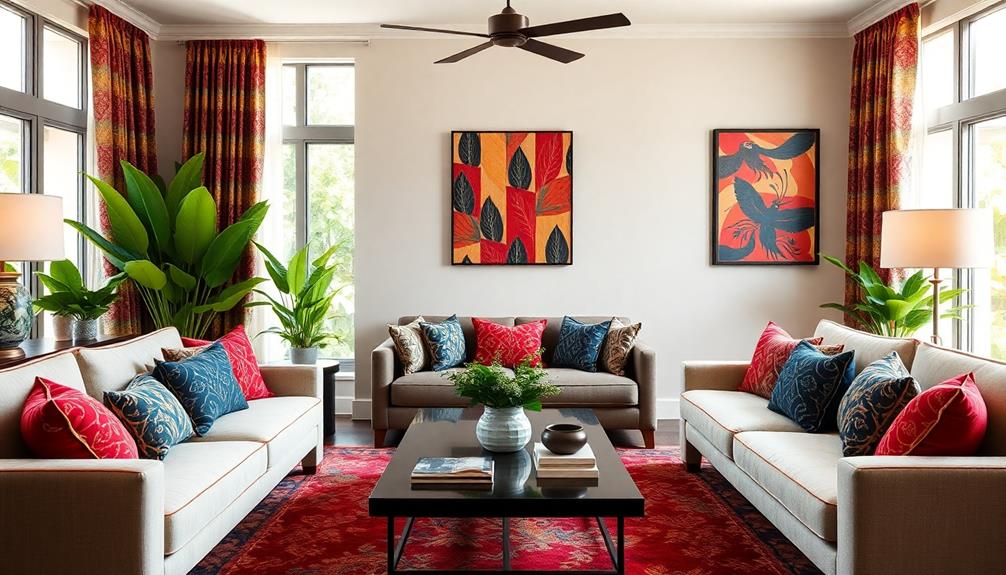
Batik is making a vibrant comeback in contemporary interior design, bringing its rich patterns and colors into modern living spaces.
You'll find batik fabric woven into a variety of accent pieces like cushions, curtains, and upholstery, adding cultural richness and unique visual interest to your home. Designers are skillfully blending traditional motifs with contemporary aesthetics, creating versatile home decor items that resonate with both heritage and modern style.
This approach mirrors the emphasis on using natural materials and traditional textiles seen in traditional Indonesian style home decor, enhancing aesthetic appeal.
Consider incorporating batik as a focal point in your space. Wall-mounted batik panels or art pieces can showcase the intricate craftsmanship of this textile art form, instantly elevating a room's design.
The growing popularity of batik in interior design reflects a broader trend of integrating cultural textiles into modern spaces, promoting global awareness and appreciation for artisanal practices.
Integrating Batik Into Interiors
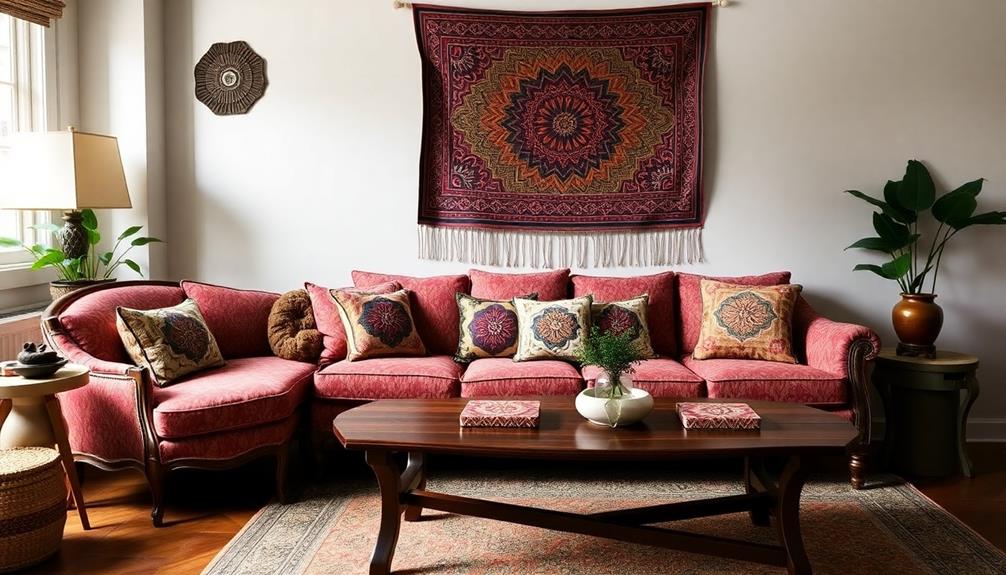
Incorporating batik into your interior design can bring a unique flair to your home while celebrating its cultural significance. Batik textiles, known for their vibrant patterns and rich heritage, enhance interior decor through cushions, curtains, and tablecloths. This perfect blend of traditional craftsmanship and modern design suits various styles, from bohemian to contemporary aesthetics.
To help you visualize how to integrate batik into your home, consider the following table:
| Element | Description |
|---|---|
| Cushions | Add color and comfort with batik prints. |
| Curtains | Create a stunning backdrop for any room. |
| Antique Batik | Use as focal points for visual interest. |
| Accent Pieces | Incorporate batik in small doses to avoid overwhelming your space. |
| Upholstery | Showcase the versatility of batik in functional furniture. |
Batik Techniques and Styles

Exploring batik techniques reveals a fascinating tapestry of artistry and tradition, each method offering unique characteristics.
You'll find that traditional batik-making primarily includes Batik Tulis, where skilled artisans hand-draw intricate designs using hot wax. This painstaking process results in exquisite patterns that showcase creativity and often incorporates cultural symbolism, reflecting the rich heritage of Indonesia's traditional housing styles.
On the other hand, Batik Cap utilizes copper stamps for quicker production, allowing for more widespread use of batik fabrics.
The dyeing technique in batik often involves applying wax, dyeing with natural colors derived from plants and minerals, and ultimately removing the wax to disclose detailed motifs.
If you're interested in modern adaptations, Batik Lukis allows for painting on fabric, merging traditional methods with contemporary artistic expression.
Don't overlook Batik Pesisir, which reflects coastal influences, characterized by bolder colors and designs aimed at commercial markets.
Finally, Batik Belanda combines Western elements with Javanese traditions, illustrating how batik adapts and evolves across cultures.
Whether you're drawn to the elegance of cotton or silk batik fabrics, each style offers something distinct for your interior design choices.
Global Influence on Batik

The intricate techniques and vibrant styles of batik have sparked a global fascination since the 1800s, as European traders introduced this unique art form to a wider audience. You can see batik's global influence in various facets of modern life, where it's embraced by international fashion designers and celebrated in contemporary styles.
| Cultural Impact | Examples |
|---|---|
| Fashion | Collections with traditional motifs |
| Decorative Arts | Adaptations in modern textiles |
| Global Reach | Influences in Nigeria, Ghana, India |
| Heritage | Recognized as a cultural symbol |
As Dutch and French artists adapted batik techniques, they contributed to the evolution of modern decorative arts, showcasing how versatile this art form can be. Today, you might spot batik on haute couture runways or worn by celebrities, further solidifying its status as a cultural symbol. The art form continues to adapt, merging with local textiles and reflecting diverse heritage, while maintaining its traditional motifs. This blend of history and innovation makes batik a fascinating subject in the world of design.
Celebrating Local Artisans and Craftsmanship

Through the revival of batik in interior design, local artisans and their craftsmanship are gaining the recognition they deserve. Supporting these artisans sustains traditional craftsmanship and fosters community development and economic growth in Indonesia.
You'll find that many batik artisans employ sustainable practices, using natural dyes and eco-friendly processes that enhance the cultural and environmental value of their work. Additionally, the integration of batik with tropical-themed luxury designs can elevate the aesthetic appeal of modern interiors.
Collaborations between designers and local artisans have led to the creation of unique, contemporary products that honor traditional techniques while appealing to modern consumers. This resurgence of batik in interior design showcases the intricate craftsmanship of local artisans in home decor items like cushions, curtains, and wall art.
Moreover, batik workshops and exhibitions are essential in highlighting the skills of these craftsmen. They provide educational opportunities that promote appreciation for this cultural heritage, especially among younger generations and tourists.
Frequently Asked Questions
What Is the Cultural Significance of Batik?
Batik's cultural significance lies in its rich history, representing diverse traditions and social values. Each motif tells a story, connecting you to community bonds and significant life events, while preserving cultural identity and artisanal craftsmanship.
What Does the Batik Symbolize?
You might think batik's just pretty fabric, but it symbolizes deep cultural heritage and identity. Each intricate pattern tells a story, revealing meanings like balance, power, and protection that connect you to rich traditions.
What Is the Basis of Modern Batik Design?
Modern batik design blends traditional motifs with contemporary aesthetics, appealing to diverse audiences. You'll find it utilizes sustainable materials and synthetic dyes, ensuring vibrant patterns while catering to eco-conscious consumers and fast-paced market demands.
What Is the Meaning of Batik Pattern Design?
Batik pattern designs carry rich meanings, reflecting cultural values and stories. Each motif you see symbolizes different beliefs, like balance, protection, or fertility, making your space not just beautiful but also meaningful and connected to heritage.
Conclusion
Incorporating batik into modern interior design not only enhances your space but also connects you to a rich cultural tapestry. By embracing the intricate motifs and techniques of this ancient art form, you celebrate both heritage and creativity. As you adorn your home with these vibrant textiles, you're not just decorating; you're telling a story that transcends time, much like a finely aged wine that only gets better with each passing year. So, go ahead and let batik inspire your surroundings!
- About the Author
- Latest Posts
Introducing Ron, the home decor aficionado at ByRetreat, whose passion for creating beautiful and inviting spaces is at the heart of his work. With his deep knowledge of home decor and his innate sense of style, Ron brings a wealth of expertise and a keen eye for detail to the ByRetreat team.
Ron’s love for home decor goes beyond aesthetics; he understands that our surroundings play a significant role in our overall well-being and productivity. With this in mind, Ron is dedicated to transforming remote workspaces into havens of comfort, functionality, and beauty.
Southeast Asia Decor
Batik: The Heartbeat of Modern Interior Design
Batik’s vibrant essence transforms modern interiors, but discover how its unique patterns can elevate your home decor in unexpected ways.
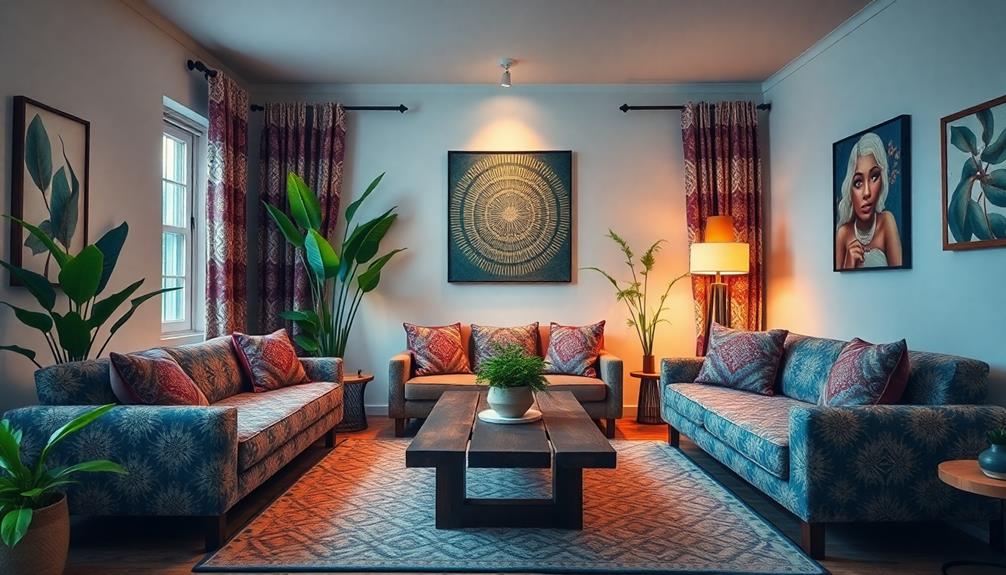
Batik's vibrant patterns and rich cultural heritage make it a standout in modern interior design. You can easily elevate your space with batik textiles, using them in cushions or as wall art to create striking focal points. This art form blends beautifully with natural materials like wood and bamboo, adding warmth and texture. By mixing bold batik designs with neutral colors, you'll craft a harmonious atmosphere that reflects personal style. So, if you're curious about how to seamlessly integrate batik into your home decor, there's plenty more to uncover that can inspire your creativity.
Key Takeaways
- Batik is an intricate Indonesian art form that enhances modern interiors with its vibrant colors and detailed patterns.
- The philosophy of Batik Interiores blends aesthetics and functionality, promoting harmony and individuality in design.
- Modern interior trends incorporate batik through innovative color palettes, texture fusion, and sustainable materials, reflecting cultural depth.
- Batik textiles add vibrancy and character to spaces, functioning well in upholstery, wall art, and accent pieces.
- Community engagement drives creativity in batik design, fostering collaboration and fresh ideas for contemporary applications.
The Essence of Batik
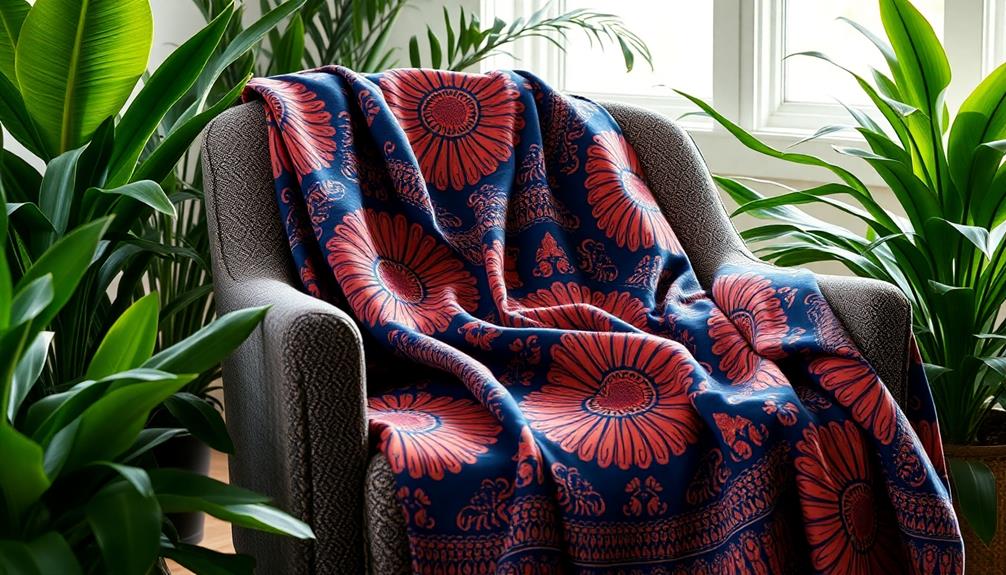
Batik's essence lies in its intricate artistry and cultural depth, offering a fascinating glimpse into Indonesian heritage. When you explore batik fabric, you'll discover a traditional dyeing technique that employs wax-resist methods to craft detailed patterns. This art form dates back over 2,000 years, showcasing its enduring significance across various cultures.
The term "batik" itself comes from the Javanese "bathikan," meaning drawing or mark-making, highlighting the skill involved in its creation. Additionally, batik is often incorporated into various decor elements, such as Indonesian decorative pillows, which reflect the vibrant colors and intricate patterns inherent in this craft.
Modern batik fabric has transformed to include contemporary designs and vibrant colors, making it a popular choice for interior decor. You can enhance your living space with batik through upholstery, curtains, and accent pieces, all while appreciating the rich textures and vivid patterns.
These designs often carry cultural significance, with specific motifs that express meanings tied to social status, nature, and history within Indonesian tradition.
Batik Interiores Philosophy
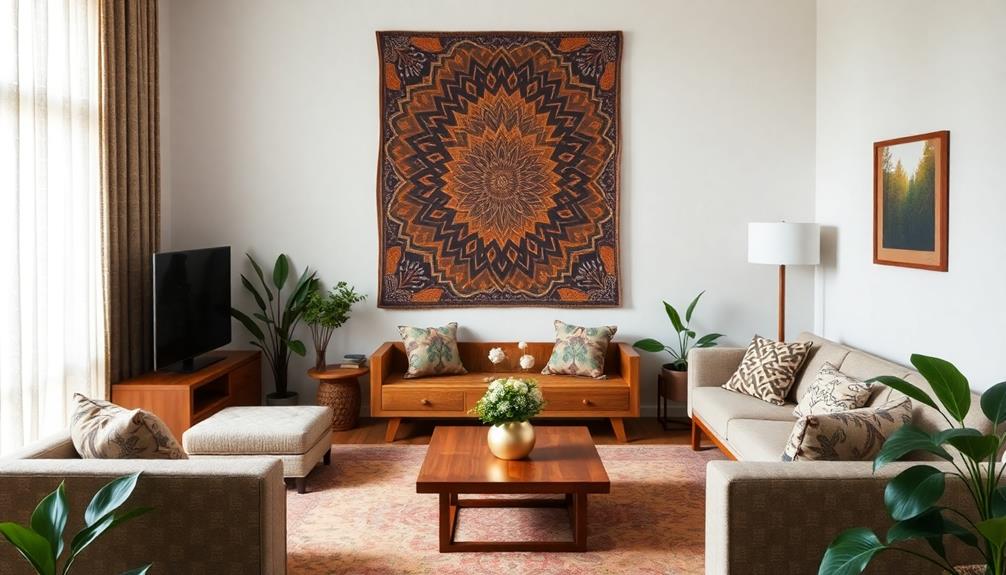
Incorporating batik into modern interior design goes beyond aesthetics; it embodies a philosophy that balances beauty with functionality. BATIK Interiores emphasizes a harmonious coexistence of design aesthetic and practicality, crafting spaces that are not only visually appealing but also functional.
This philosophy prioritizes individuality, power, harmony, and warmth, ensuring every design reflects your unique personality. The careful selection and balance of items is essential for enhancing livability and overall well-being.
| Element | Importance | Impact |
|---|---|---|
| Aesthetics | Creates visual appeal | Engages and inspires emotion |
| Functionality | Enhances usability | Supports daily activities |
| Light | Influences ambiance | Affects mood and comfort |
Trends in Modern Interior Design

In modern interior design, you're seeing exciting innovations in color palettes that energize spaces and influence moods.
The integration of traditional elements, such as Indonesian decor masks, adds a cultural depth and storytelling aspect to contemporary aesthetics.
Texture and pattern fusion has become essential, allowing you to mix different materials and designs for a unique look.
Plus, sustainable material choices, like batik, not only enhance aesthetics but also reflect a commitment to eco-friendly living.
Color Palette Innovations
Vibrant color palettes are revolutionizing modern interior design, and batik-inspired hues are leading the charge. You'll find that rich shades like deep blues, warm yellows, and soft pinks not only create dynamic spaces but also serve as powerful design inspiration.
Additionally, incorporating elements like the Indonesian decor mask can enhance the cultural richness of your interior. By blending traditional batik colors with contemporary materials, you can achieve a harmonious balance that resonates with both heritage and modern aesthetics.
Consider these elements to elevate your interior design:
- Contrast: Use bold batik patterns in textiles and wallpapers to create striking visual interest against neutral furnishings.
- Layering: Mix and match batik fabrics with solid colors. This layered look adds depth and personality to your space.
- Textures: Incorporate geometric and ethnic textures derived from batik, enhancing modern style while celebrating cultural significance.
- Innovative Materials: Explore the use of velvet and faux marble alongside batik patterns to create a luxurious, contemporary vibe.
These innovative color palette trends breathe new life into your space, allowing you to express your unique style while embracing the beauty of batik.
Texture and Pattern Fusion
Texture and pattern fusion is transforming modern interior design by seamlessly blending diverse materials, including batik textiles and Indonesian decor masks, to create visually enchanting spaces.
By incorporating batik patterns into your decor, you can reflect your personal style and cultural heritage while adding depth and character to your home. Designers are increasingly choosing batik-inspired motifs, often pairing them with solid colors to establish a balanced visual narrative.
Hand-drawn batik patterns are especially popular now, offering a sense of authenticity and artistry that resonates with those of you seeking personalized decor. These unique designs not only enhance the aesthetic appeal of your space but also celebrate traditional craftsmanship in a contemporary context.
The versatility of batik allows it to fit various design styles, from bohemian to modern minimalist, making it an adaptable choice for any interior.
As you explore texture and pattern fusion, consider using batik for accent pieces like cushions, wall art, or even throw blankets. This approach not only elevates your design but also invites conversation and admiration, transforming your living space into a mesmerizing reflection of who you are.
Sustainable Material Choices
As you embrace the fusion of textures and patterns in your interior design, consider how sustainable material choices can further enhance your space.
Integrating elements of tropical contemporary house design can also elevate your aesthetic while staying environmentally conscious. Sustainable interior design isn't just a trend; it's a commitment to a healthier planet and your well-being.
By opting for eco-friendly materials, you're not only beautifying your home but also making a positive impact.
Here are four sustainable material choices to inspire you:
- Reclaimed Wood: Every piece has a story, adding character and warmth to your space.
- Bamboo: Fast-growing and renewable, it's a stylish alternative that benefits the environment.
- Organic Fabrics: Soft, breathable, and free from harmful chemicals, they contribute to healthier living.
- Recycled Plastics: Innovative and practical, these materials help reduce waste while looking chic.
With certifications like LEED and FSC, you can trust that your choices support responsible sourcing.
Plus, the rise of biodegradable and non-toxic options makes it easier than ever to create a stunning interior that reflects your values.
Embrace sustainable material choices, and let your home tell a story of style, responsibility, and connection to nature.
Integrating Batik Into Home Decor
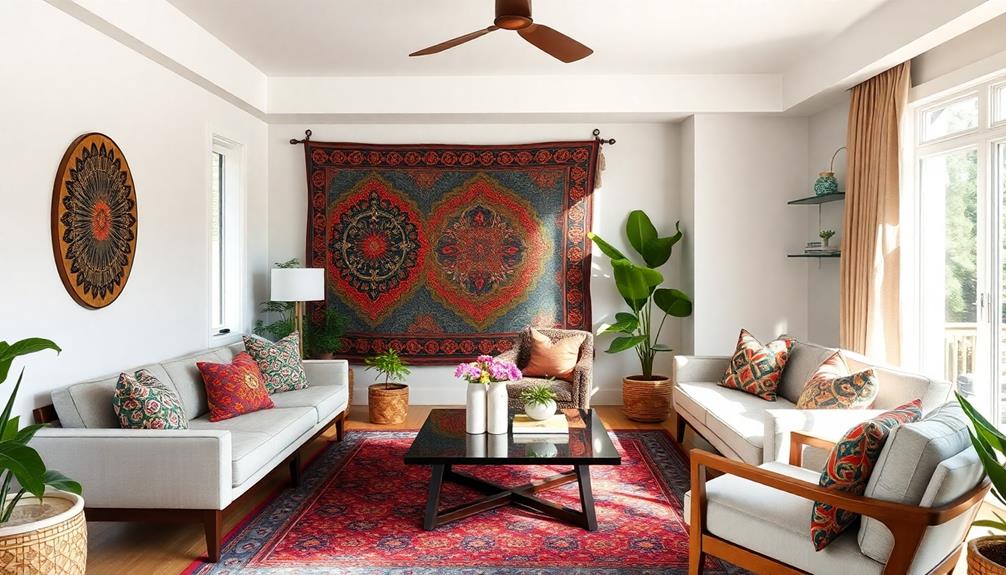
When integrating batik into your home decor, start by selecting vibrant patterns that resonate with your personal style.
Consider incorporating elements of traditional Indonesian style to enhance the aesthetic appeal, as batik beautifully complements natural materials like wood and bamboo.
Pair these patterns with complementary color schemes to create a cohesive look that enhances your space.
Don't forget practical application tips, like using batik for upholstery or as wall art, to make a bold statement without overwhelming your design.
Vibrant Pattern Selection
Incorporating batik-inspired textiles into your home decor instantly adds a splash of vibrancy and character. With their intricate patterns, these textiles can elevate your interior design, making each room feel more inviting.
Additionally, Balinese design characteristics celebrate the use of traditional motifs, which can beautifully complement the rich textures of batik. When you're ready to make a vibrant pattern selection, consider these four inspiring ideas:
- Accent Cushions: Throw pillows covered in bold batik designs can transform your sofa into a vibrant focal point.
- Dramatic Curtains: Hang batik-patterned curtains to create an eye-catching backdrop that enhances natural light while adding texture.
- Unique Upholstery: Reupholster a vintage chair or an ottoman with batik fabric for a statement piece that tells a story.
- Artistic Throws: Drape a batik throw over a neutral armchair to introduce warmth and cultural flair to your space.
The versatility of batik allows it to blend seamlessly with various design styles, from modern bohemian to traditional.
Complementary Color Schemes
Batik textiles can truly bring a room to life, but pairing them with the right colors is key to creating a cohesive look. Complementary color schemes, which involve colors opposite each other on the color wheel, can enhance the vibrant patterns found in batik. For instance, using blue and orange can create a striking balance that highlights the intricacy of the batik design.
Additionally, incorporating elements of traditional Indonesian housing can inspire the overall aesthetic of your space, blending cultural heritage with modern decor.
When integrating batik into your modern interior, consider the dominant colors within the textile. This will guide you in selecting complementary hues for your walls, furniture, and accessories, ensuring a harmonious environment. Using batik in accent pieces like cushions or throws allows you to incorporate rich colors without overwhelming the decor.
Don't shy away from experimenting with various shades and tones of complementary colors. This can lead to dynamic and visually appealing spaces where your batik textiles shine as focal points.
Practical Application Tips
Integrating batik into your home decor can be both exciting and rewarding, as it allows you to infuse your space with cultural richness and artistic flair.
To enhance the tropical aesthetic of your interiors, consider incorporating elements from luxury tropical design aesthetics that complement batik patterns. Here are some practical tips to help you seamlessly incorporate batik designs into your interior:
- Accent Pieces: Use batik textiles like throw pillows or cushions to introduce vibrant patterns without overwhelming your space. These small touches can make a big impact.
- Feature Walls: Consider batik-inspired wallpaper to create a stunning feature wall. It adds depth and character, but ascertain it complements your overall color scheme for a harmonious design.
- Upholstery: Incorporate batik fabric in your furniture upholstery. This unique touch reflects your personal style while still being functional.
- Layering Textiles: Combine batik with solid color fabrics and natural materials like cotton or leather. This balance prevents visual clutter and enhances texture, creating a warm, inviting atmosphere.
Unique Batik Products and Inspirations
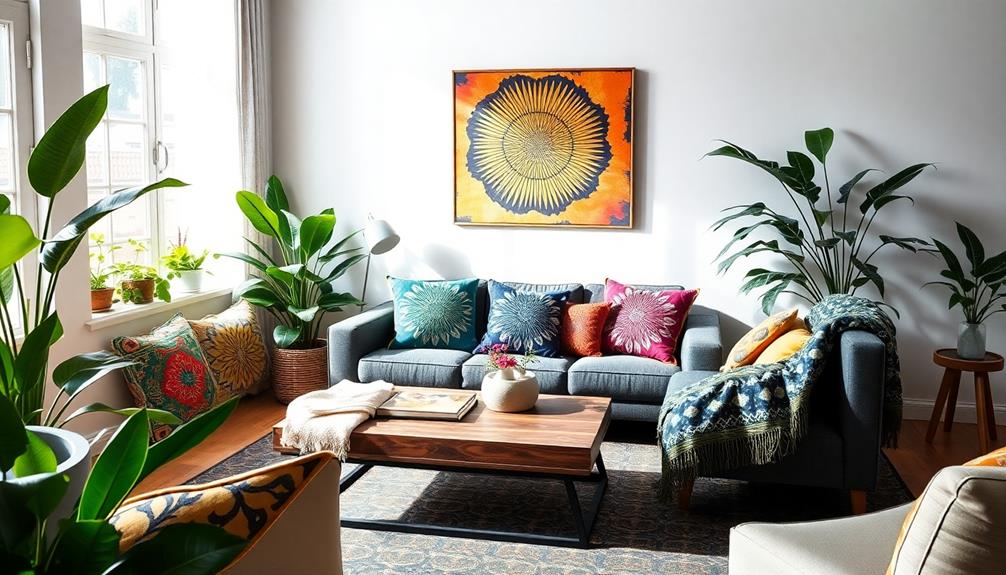
Unique batik products, like stunning bespoke furniture and vibrant textiles, can transform your living space into a work of art. These pieces showcase intricate patterns and craftsmanship that elevate modern interior design aesthetics.
Imagine a statement chair upholstered in rich batik fabric, or a coffee table featuring batik-inspired faux marble accents. Each product tells a story, drawing inspiration from natural landscapes and historical motifs, resulting in distinctive patterns that resonate with contemporary decor themes.
By incorporating elements from luxury tropical designs, batik can seamlessly blend with modern aesthetics while adding a touch of cultural richness.
The versatility of unique batik products allows them to shine in various forms, including wall art, upholstery, and decorative accents. This flexibility means you can easily incorporate batik into any room, adding character and depth to your space.
By blending traditional techniques with modern design elements, batik celebrates cultural heritage while appealing to current tastes.
To achieve a luxurious feel, consider using rich materials like velvet alongside batik designs. This combination not only enhances the aesthetic but also maintains a connection to the craftsmanship that defines batik.
Embrace the beauty of unique batik products, and watch as your home transforms into a vibrant, culturally rich haven that reflects your style.
Community Engagement and Feedback
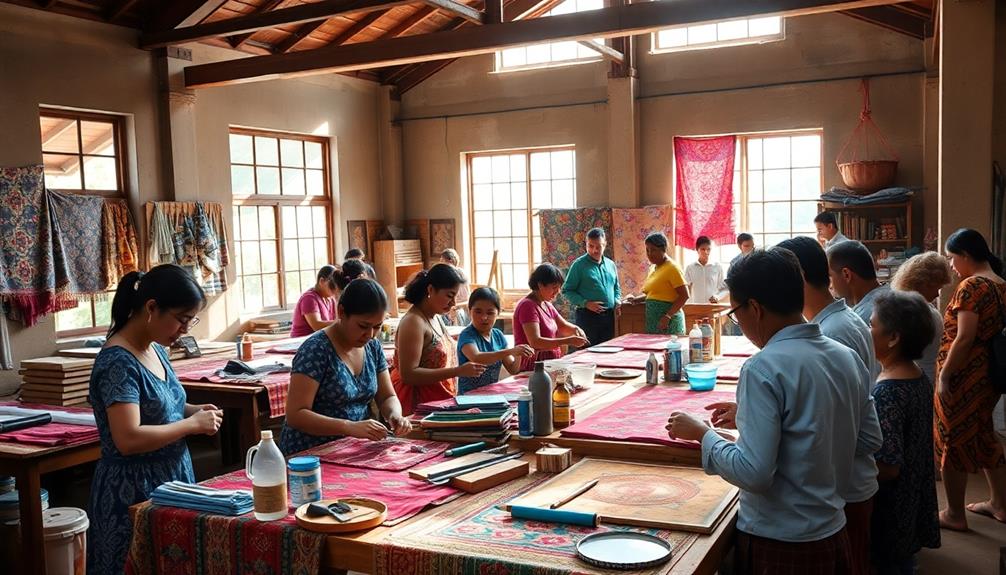
Incorporating batik into modern interior design isn't just about the products; it's also about the vibrant community that surrounds this art form.
Community engagement plays a significant role in shaping your design journey. By actively seeking feedback and interacting with fellow quilters, you open the door to collaboration and shared inspiration.
Here's why engaging with your community matters:
- Supportive Comments: When you share your designs, the encouraging feedback fosters a positive atmosphere for creativity.
- Open Dialogue: Maintaining an ongoing conversation allows everyone's voices to be valued and integrated into future projects.
- Innovative Ideas: Community feedback is essential, guiding the direction of new fabric designs and collections that resonate with shared tastes.
- Social Media Connection: Platforms like Instagram and Facebook create spaces for interaction, showcasing your designs while gathering fresh perspectives.
The Future of Batik Design
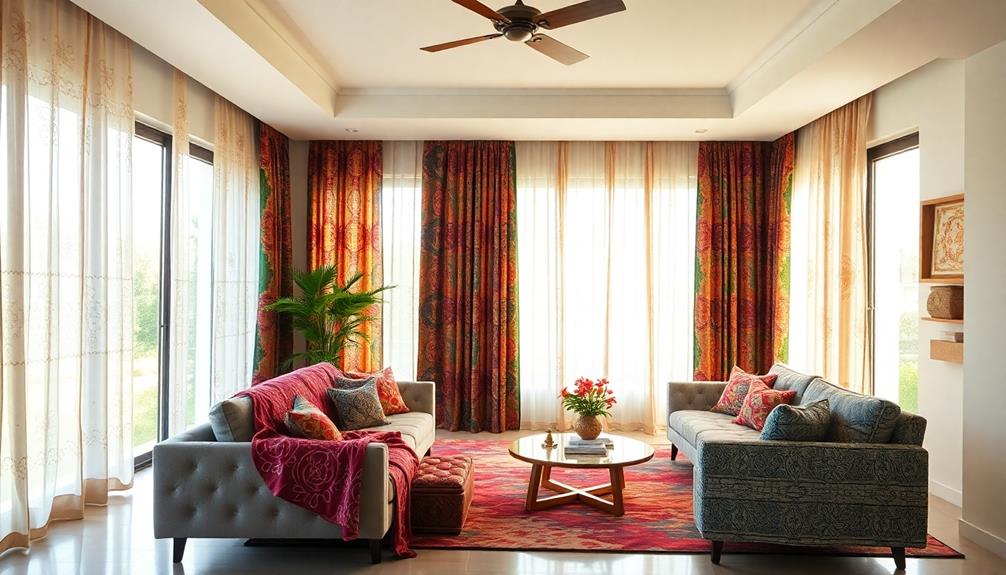
The future of batik design is set to embrace a dynamic blend of tradition and modernity, appealing to both established enthusiasts and new admirers alike.
As an interior designer, you'll find yourself at the forefront of this exciting evolution. Modern interpretations of batik are integrating traditional techniques with contemporary aesthetics, broadening its appeal across diverse audiences.
You'll notice designers experimenting with vibrant color palettes and playful patterns, encouraging a mix-and-match approach in home decor and fashion.
Innovations in textile technology are also enhancing batik fabrics, allowing them to retain the craftsmanship of traditional methods while introducing fresh design possibilities.
With consumers increasingly prioritizing sustainable and ethically produced textiles, you'll see batik design adapting to these values.
This growing demand for eco-friendly options honors cultural heritage while ensuring relevance in today's market.
Collaborative efforts between traditional artisans and modern designers are essential in this revival, fostering creativity and ensuring batik's adaptability in the ever-evolving landscape of interior design.
Frequently Asked Questions
What Is the Basis of Modern Batik Design?
Modern batik design blends traditional techniques with contemporary aesthetics. You'll see vibrant colors and innovative patterns, influenced by designers like Alison Glass. Experimentation and hand-drawn details create unique pieces that reflect current trends and craftsmanship.
Why Is Batik Important?
Batik's importance lies in its fusion of tradition and innovation. You'll find its rich patterns breathe life into spaces, bridging cultural heritage with modern aesthetics, creating environments that resonate warmth, storytelling, and individuality.
What Is a Batik Design?
A batik design is a textile pattern created using a wax-resist dyeing technique. You'll see intricate motifs that often hold cultural significance, showcasing artistry and tradition, while also adapting to modern aesthetics and color palettes.
Why Is Batik a Unique Form of Art?
Batik's uniqueness lies in its intricate wax-resist dyeing technique, allowing you to create stunning patterns. Each piece reflects cultural narratives and personal expression, making it a vibrant art form that connects you to rich traditions.
Conclusion
As you weave batik into your home, you're not just decorating; you're stitching together stories of culture and creativity. Each vibrant pattern dances across your walls, breathing life into your space, like a warm embrace on a chilly day. Embrace the tapestry of tradition and contemporary flair, and let batik be the heartbeat of your modern interior. With every piece you choose, you're not just enhancing your decor; you're celebrating a rich heritage that inspires and connects us all.
- About the Author
- Latest Posts
Introducing Ron, the home decor aficionado at ByRetreat, whose passion for creating beautiful and inviting spaces is at the heart of his work. With his deep knowledge of home decor and his innate sense of style, Ron brings a wealth of expertise and a keen eye for detail to the ByRetreat team.
Ron’s love for home decor goes beyond aesthetics; he understands that our surroundings play a significant role in our overall well-being and productivity. With this in mind, Ron is dedicated to transforming remote workspaces into havens of comfort, functionality, and beauty.
Southeast Asia Decor
7 Tips for Batik Symbolism in Modern Interiors
Bring your modern interiors to life with batik symbolism through these seven essential tips that will completely transform your space. Discover the secrets inside!

To enhance your modern interiors with batik symbolism, start by embracing traditional motifs like Parang and Kawung for a touch of heritage. Choose complementary colors to create balance, letting vibrant batik patterns shine. Integrate textiles thoughtfully, pairing them with solid elements to avoid overwhelming the space. Use batik pieces as focal points to draw attention and spark conversation. Mix these designs with contemporary elements for a stylish contrast. Highlight cultural stories behind the motifs to deepen your decor's meaning. Finally, maintain visual balance by selecting just a few standout pieces. You'll discover even more strategies that can transform your space beautifully.
Key Takeaways
- Incorporate traditional batik motifs like Parang and Kawung to symbolize continuity and prosperity in modern interiors.
- Use batik textiles as statement pieces to highlight cultural stories and add depth to your decor.
- Balance vibrant batik patterns with solid elements to maintain harmony and prevent visual overwhelm in your space.
- Select batik as focal points in key areas to create conversation starters and elevate the aesthetic appeal of your home.
- Experiment with complementary colors from batik fabrics to enhance mood and ensure cohesive integration within your existing color scheme.
Embrace Traditional Motifs
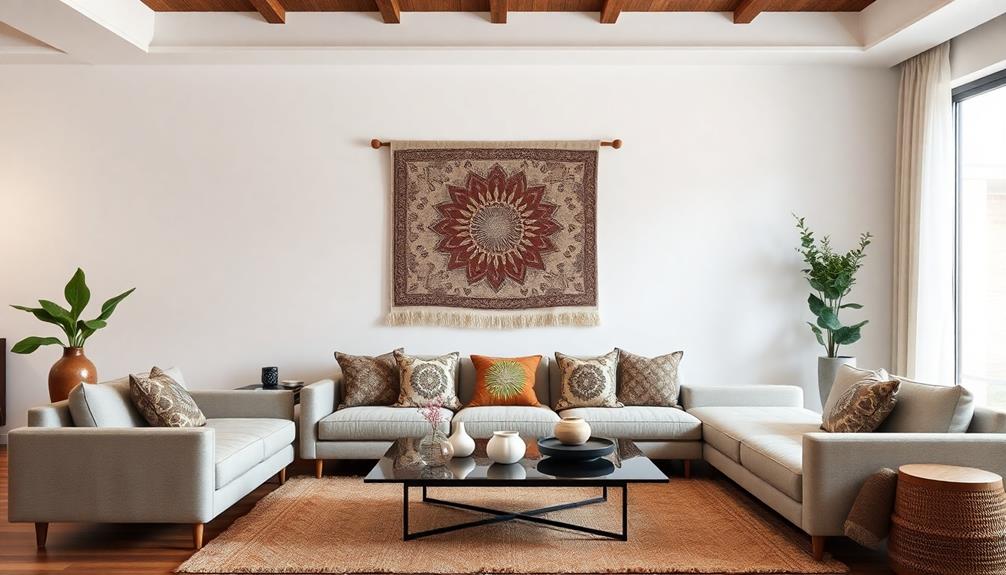
Embracing traditional motifs in your modern interior can transform your space into a vibrant tapestry of culture and history. Incorporating batik motifs like Parang and Kawung not only enhances aesthetic appeal but also adds a layer of cultural heritage to your home.
These designs carry significant meanings, highlighting themes of continuity and prosperity. Additionally, using Indonesian Decorative Pillows featuring batik patterns can further enrich your decor while providing comfort.
You can utilize traditional batik textiles as wall art or upholstery, creating striking focal points that serve as conversation starters. Selecting specific designs, such as Mega Mendung, can influence the mood of a room; its calming cloud motif promotes tranquility in a bedroom.
Mixing batik with contemporary furniture creates a harmonious balance between traditional and modern styles, ensuring your decor feels unique and inviting.
Emphasizing batik symbols like Sido Luhur can further enrich your living space, infusing it with positive energy and personal significance.
Choose Complementary Colors
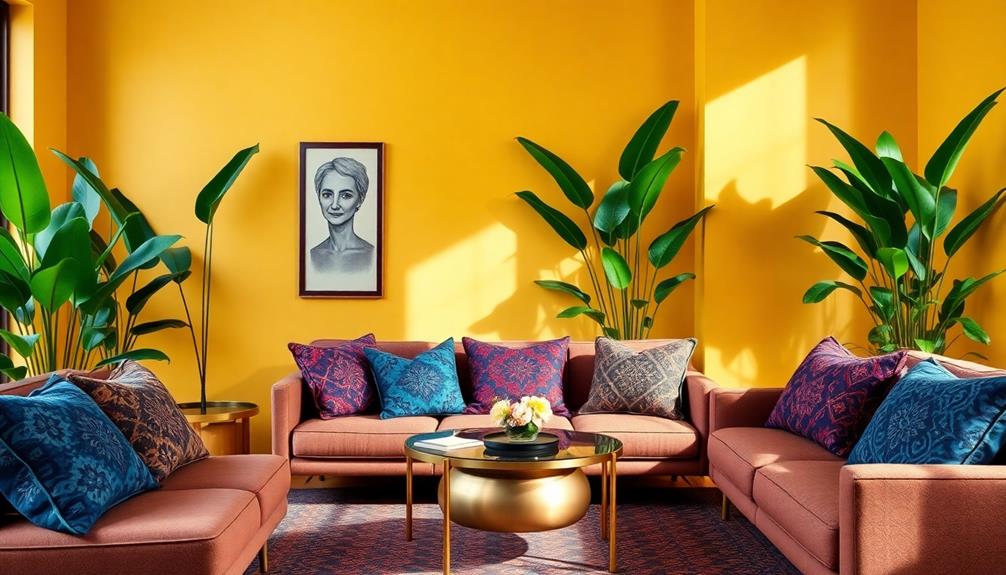
When you choose complementary colors for your batik decor, think about how they interact with your existing elements.
Incorporating elements like traditional artistry can help enhance the vibrancy of your batik patterns.
Balancing accent and dominant colors helps create harmony while ensuring the vibrant batik patterns shine without overwhelming the space.
Color Harmony Principles
Choosing complementary colors is essential for creating a vibrant and visually appealing space when incorporating batik textiles into modern interiors. By selecting colors that sit opposite each other on the color wheel, you can enhance the vibrancy of your batik patterns and establish a striking contrast.
Here's a quick guide to help you choose complementary colors effectively:
| Warm Colors | Complementary Color | Use Case |
|---|---|---|
| Red | Green | Living room textiles |
| Yellow | Purple | Dining area accents |
| Orange | Blue | Accent pillows |
| Pink | Teal | Bedroom decor |
Incorporating warm batik designs can evoke warmth and energy, perfect for social spaces. On the other hand, cool-toned batik patterns promote tranquility, ideal for bedrooms. To achieve true color harmony, consider mixing your batik textiles with solid colors within the same family. This approach allows the intricate batik patterns to shine without overwhelming the area. Experimenting with different shades of a color found in your batik fabrics can also create depth, making your interior feel cohesive yet dynamic.
Accent vs. Dominant Colors
In modern interiors, finding the right balance between accent and dominant colors is essential for showcasing the beauty of batik textiles. When you integrate batik patterns into your space, choose accent colors from the fabric that complement the room's dominant shades. This creates a harmonious design that draws the eye without overwhelming the decor.
Incorporating elements like Indonesian decor masks alongside batik can enhance the cultural depth of your interior while maintaining visual interest.
Using batik pieces with vibrant colors as focal points against neutral backgrounds allows the intricate designs to shine. Consider the psychology of color; warm tones can create a cozy atmosphere, while cool tones evoke calmness.
Mixing batik textiles with solid color furnishings helps maintain balance, ensuring the batik patterns remain the centerpiece.
To enhance visual interest, select complementary colors that echo the motifs in the batik. Pair a batik print with matching throw pillows or art pieces that reflect similar hues.
This thoughtful approach to accent colors not only elevates your interior design but also celebrates the rich cultural significance of batik. Remember, the goal is to create a cohesive look where each element enhances the other, allowing the beauty of your batik textiles to truly stand out.
Integrate Textiles Thoughtfully
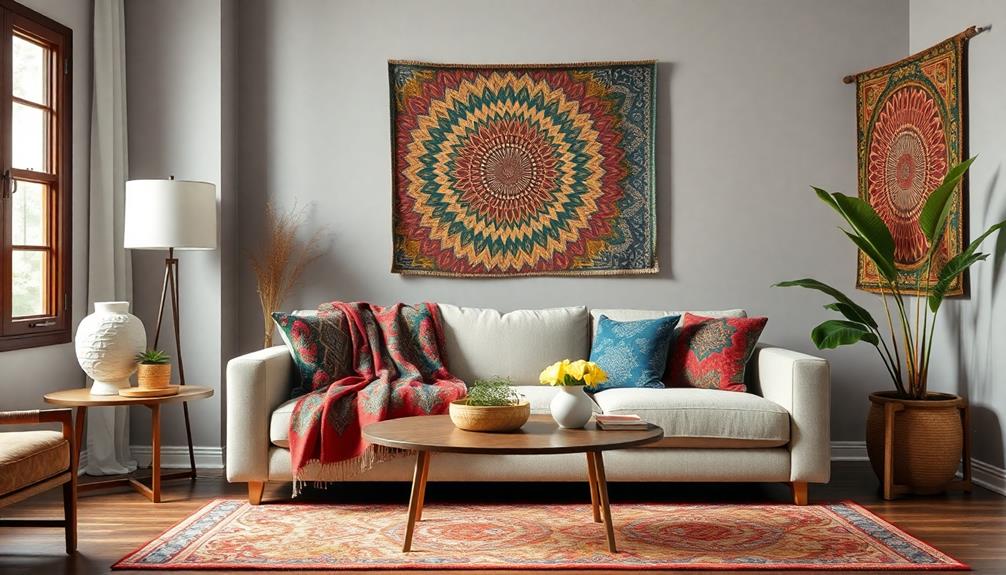
When integrating batik textiles into your space, think about how they complement your color scheme.
Incorporating traditional motifs and patterns can enhance the cultural significance of your decor, making it more meaningful. Mixing batik with solid elements helps maintain a balanced look, so the patterns enhance rather than overwhelm your decor.
By choosing colors that resonate with your overall design, you can create a harmonious atmosphere that feels both inviting and stylish.
For inspiration, consider exploring Indonesian wedding decor ideas.
Choose Complementary Color Schemes
Integrating batik textiles into your modern interior can transform a space, especially when you select complementary color schemes that resonate with your existing decor.
Start by identifying colors within your chosen batik patterns; these textiles often feature a blend of earthy tones and vibrant hues from traditional batik-making. Pair warm earth tones with cooler accent colors to create a harmonious balance that enhances the overall aesthetic.
Additionally, consider incorporating elements of Balinese design characteristics that harmonize with your batik textiles, such as natural materials and open spaces that promote a connection to nature.
Consider the scale of your batik patterns as you decide where to place them. Larger motifs can act as striking statement pieces, while smaller patterns work beautifully as accents, such as in cushions or throws. This allows you to introduce batik textiles into various areas without overwhelming the environment.
To further highlight the intricate designs of your batik textiles, utilize neutral backgrounds. This approach not only emphasizes the beauty of the fabrics but also maintains a serene atmosphere in your space.
Balance With Solid Elements
To create a balanced and inviting space, pair your vibrant batik textiles with solid elements that ground the design. Mixing solid-colored furniture and decor items with batik patterns provides a visual anchor that complements the bold motifs while maintaining an elegant look. Opt for neutral tones to enhance the intricate designs without overwhelming your interiors.
Using batik textiles as accent pieces, like cushions or throws, introduces cultural elements subtly, ensuring they enhance rather than dominate the overall aesthetic. Consider the scale of your batik prints; larger patterns can be beautifully balanced with smaller solid elements, creating a harmonious interplay of textures and colors.
A layered approach works wonders too. For instance, using a batik table runner on a solid tablecloth adds depth while preserving the integrity of both fabrics. Here's a quick reference to help you balance solid elements with batik textiles:
| Solid Element Type | Suggested Batik Piece | Ideal Placement |
|---|---|---|
| Neutral Sofa | Batik Cushions | On the sofa |
| Solid Coffee Table | Batik Table Runner | On the table |
| Plain Curtains | Batik Throw | On a chair |
Use Batik as Focal Points

Batik can transform your space by serving as a striking focal point that captures attention and adds depth to your decor.
By thoughtfully incorporating batik elements, you can create an inviting atmosphere that showcases the beauty of these traditional patterns. Additionally, using batik decor can promote appreciation for Indonesian artistry and craftsmanship, enhancing the cultural richness of your home cultural decor enthusiasts.
Here are three effective ways to use batik as focal points in your home:
- Batik Wall Hangings: Use large batik wall hangings or framed fabric pieces as statement art. They draw the eye and create a vibrant atmosphere in any room.
- Upholstered Furniture: Consider batik upholstered furniture, like chairs or sofas, to introduce rich colors and intricate designs that can become the centerpiece of your living space.
- Textiles in Decor: Display batik cushions and throws on neutral-colored sofas or beds. They highlight the unique patterns and add a touch of cultural elegance to your decor.
Mix With Contemporary Elements

Adding batik elements to your decor doesn't mean sticking solely to traditional styles. You can seamlessly mix batik fabric with modern design to create a unique aesthetic.
Consider incorporating batik patterns into contemporary furniture, like upholstered chairs or ottomans, which aligns with the principles of modern tropical aesthetics in Bali. This allows you to showcase traditional artistry while embracing clean lines and minimalism.
Using batik textiles as wall art adds another layer of artistic expression to your space. Frame pieces or create a gallery wall, letting the vibrant colors and intricate patterns become focal points in otherwise minimalist environments.
You can also blend batik with modern textiles—think solid-colored cushions or throws—to maintain an elegant, cohesive look in your living areas.
Combine batik elements with sleek metallic accents, such as gold or silver decor items, to enhance the richness of the fabric while adding a contemporary flair.
Ultimately, consider batik-inspired wallpapers or decals in your modern spaces. They allow timeless motifs to add depth and cultural richness without overwhelming your design.
Highlight Cultural Stories

Incorporating batik textiles into your modern interiors can transform your space into a rich tapestry of cultural stories. Each piece tells a tale, offering a glimpse into traditions and heritage that can captivate your guests.
As traditional Indonesian housing, or Rumah Adat, reflects deep cultural significance, so too can batik textiles enrich your home with their historical narratives.
Here are three ways to highlight these narratives:
- Choose Iconic Batik Motifs: Select pieces with significant meanings, like the Parang, representing continuity and ocean waves, enriching your decor with a royal Indonesian legacy.
- Emotional Connections: Display textiles featuring symbols like Sido Asih, which embodies love. This not only beautifies your space but also enhances emotional resonance.
- Showcase Cultural Craftsmanship: Use batik items as accent pieces to demonstrate your appreciation for the intricate artistry and stories behind each design.
Maintain Balance in Design
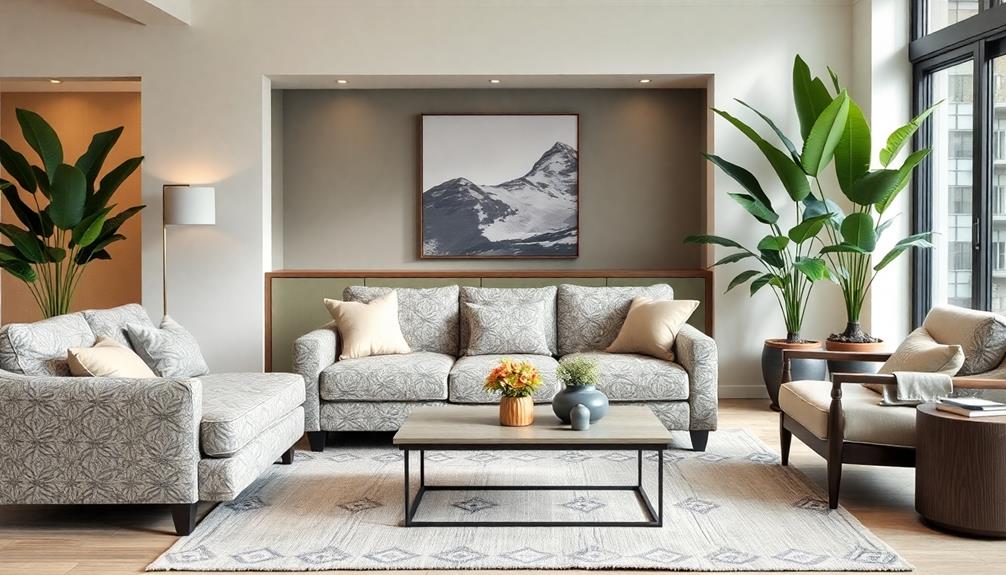
Achieving harmony in interior design often hinges on the balance of elements within a space. When incorporating batik into your modern interiors, start by selecting one or two prominent batik pieces as focal points. This prevents your space from feeling overcrowded with patterns and allows the intricate details of the batik design to shine.
For a truly immersive experience, consider integrating elements from traditional Indonesian style home decor that resonate with the cultural significance of batik. Complement bold batik designs with solid color furnishings, creating a harmonious contrast that enhances the overall decor.
Consider using batik in accent pieces like throw pillows or wall art. This approach not only allows for easy seasonal updates but also maintains a cohesive design theme throughout the room. Pay attention to the scale of batik patterns; larger motifs can dominate a space, so pair them with smaller, subtler designs to maintain visual balance and interest.
Integrate batik into a layered design by mixing traditional garments with modern art and textures like wood, metal, or natural fibers. This creates depth and an inviting atmosphere while keeping your decor elegant.
Frequently Asked Questions
What Does the Batik Symbolize?
Batik symbolizes various cultural meanings, like honor, unity, and power. By understanding these motifs, you can appreciate their significance, enhancing your connection to the rich traditions they represent while adding beauty to your environment.
What Are the 5 Major Types of Batik Design Motif?
The five major batik motifs you should know are Kawung, Parang, Sido Asih, Mega Mendung, and Ceplok. Each design carries unique meanings and can enhance your interior decor with cultural significance and aesthetic appeal.
What Is the Basis of Modern Batik Design?
Modern batik design combines traditional motifs with contemporary aesthetics, much like a smartphone blends technology and style. You'll see nature-inspired themes and vibrant colors, reflecting cultural stories while appealing to today's audience.
What Are the Three Main Elements of Batik Pattern?
The three main elements of batik patterns are motifs, colors, and arrangement. You'll notice how motifs symbolize nature and values, colors convey emotions, and arrangement enhances the flow, creating meaningful and enchanting designs.
Conclusion
Incorporating batik into your modern interiors can create a beautiful harmony between tradition and contemporary design. For instance, imagine a living room where a bold batik throw pillow complements sleek, minimalist furniture, telling a story of rich heritage. By following these tips, you'll not only enhance your space but also celebrate the cultural significance behind the patterns. Embrace the journey of blending old and new, and watch your home come alive with character and meaning.
- About the Author
- Latest Posts
Introducing Ron, the home decor aficionado at ByRetreat, whose passion for creating beautiful and inviting spaces is at the heart of his work. With his deep knowledge of home decor and his innate sense of style, Ron brings a wealth of expertise and a keen eye for detail to the ByRetreat team.
Ron’s love for home decor goes beyond aesthetics; he understands that our surroundings play a significant role in our overall well-being and productivity. With this in mind, Ron is dedicated to transforming remote workspaces into havens of comfort, functionality, and beauty.
-

 Retreat2 weeks ago
Retreat2 weeks agoDIY Aromatherapy Diffusers for a Spa-Like Atmosphere at Home
-

 Retreat3 weeks ago
Retreat3 weeks agoThe Profitability of Retreat Centers: A Financial Analysis
-

 Retreat1 week ago
Retreat1 week ago10 Unique Themed Room Ideas for Your Retreat Center
-

 Southeast Asia Decor7 days ago
Southeast Asia Decor7 days agoIndonesian Textiles Shaping Contemporary Interior Design
-

 Retreat2 weeks ago
Retreat2 weeks agoThe Psychology of Color in Retreat Center Design
-

 Retreat2 weeks ago
Retreat2 weeks agoUnusual DIY Projects: Designing a Space Probe in Bitlife
-

 Retreat3 weeks ago
Retreat3 weeks agoComprehensive Review: Are Home Decorators Ceiling Fans Worth the Investment?
-

 Retreat2 weeks ago
Retreat2 weeks agoHow to Create a Zen Garden for Your Retreat Center































